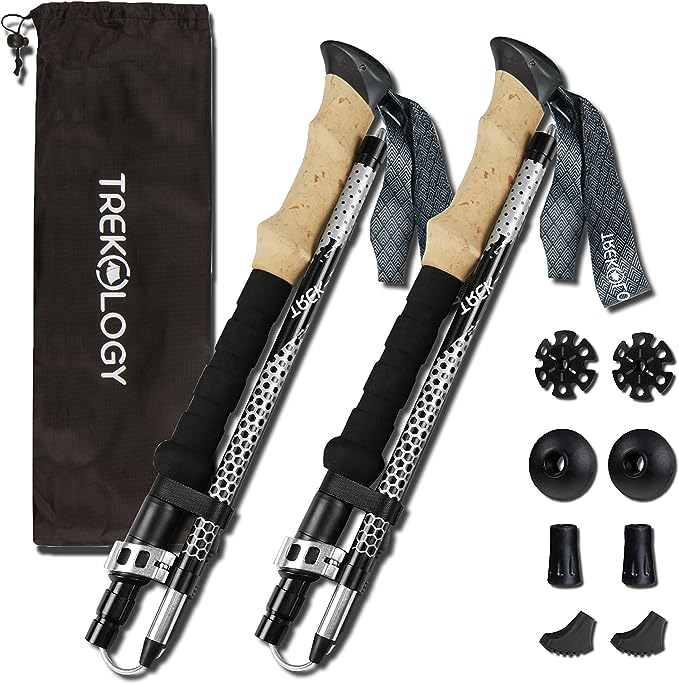Are you thinking about taking up trekking? Or maybe you’re already an avid hiker looking to take your outdoor adventures to the next level. Whatever your experience level, choosing the right trekking poles can make a world of difference in your hiking experience. In this blog post, we’ll cover everything you need to know about selecting the perfect trekking poles for your needs. From understanding the different types of trekking poles to considering factors like weight, material, adjustability, and comfort features, we’ll explore all the essential aspects of choosing the right trekking poles. Additionally, we’ll compare trekking poles for different terrains and conditions, so you can be well-equipped for whatever your outdoor adventures may bring. So, whether you’re trekking through rugged mountainous terrain or winding forest paths, this guide will help you make an informed decision when it comes to choosing the perfect trekking poles for your next adventure.Discover the different types of trekking poles, essential factors to consider, and the importance of weight, material, adjustability, and comfort features. Compare poles for various terrains.
Understanding The Types Of Trekking Poles
Trekking poles come in a variety of types, each with its own unique features and benefits. One of the most common types is the telescoping pole, which allows for easy adjustment of height to accommodate different terrains and user heights. Another type is the folding pole, which is designed for easy storage and portability. There are also fixed-length poles, which are lightweight and durable, making them ideal for long-distance trekking. And finally, there are shock-absorbing poles, which reduce strain on the arms and wrists during long hikes.
When selecting the right type of trekking pole, it’s important to consider factors such as the terrain you will be trekking on, your own height and stride, and the type of activities you will be doing. If you will be encountering steep ascents and descents, telescoping poles may be the best choice. For those looking for portability, folding poles may be the most practical option. Fixed-length poles are better suited for those who prioritize durability and minimal weight, while shock-absorbing poles are ideal for those who want to reduce strain on their joints.
The type of material used in the construction of a trekking pole can greatly impact its weight, durability, and performance. Aluminum poles are lightweight and affordable, making them a popular choice for casual hikers. Carbon fiber poles, on the other hand, are extremely lightweight and offer excellent shock absorption, but they tend to be more expensive. Understanding the pros and cons of each material can help you make an informed decision when selecting a trekking pole.
Overall, understanding the different types of trekking poles available can help you make a more informed decision when making a purchase. By considering your specific needs and the type of terrain you will be encountering, you can select the type of pole that best suits your individual preferences and requirements.
Factors To Consider When Selecting The Right Trekking Poles
When choosing the right trekking poles, there are several factors to take into consideration in order to ensure that you have the best equipment for your outdoor adventures. One of the most important factors to consider is the material of the trekking poles. The material determines the durability, weight, and flexibility of the poles, and it is important to choose a material that suits your specific needs and preferences. For example, aluminum poles are lightweight and durable, making them suitable for most hiking and trekking activities. On the other hand, carbon fiber poles are even lighter and more flexible, but they may also be more expensive.
Another crucial factor to consider when selecting the right trekking poles is the grip and handle design. The grip of the pole should be comfortable and ergonomic, providing a secure hold and minimizing fatigue during long hikes. Some trekking poles come with adjustable or extendable grips, allowing you to customize the length and angle of the grip to suit your hand size and hiking style. Additionally, the wrist strap design is an important consideration, as it helps to distribute the weight of the pole and reduce strain on your wrists and arms.
Weight is also a significant factor to take into account when choosing trekking poles. It is essential to find a balance between lightweight poles for easy handling and heavy-duty poles for rugged and challenging terrains. Additionally, collapsible or foldable poles are ideal for compact storage and convenient transportation, especially for backpacking and multi-day hiking trips. Ultimately, the weight of the trekking poles will impact your overall comfort and mobility during outdoor activities, so it is important to choose poles that best suit your individual preferences and physical capabilities.
Lastly, the locking and adjustment mechanism of the trekking poles is an important consideration, as it ensures stability, safety, and ease of use. There are different types of locking mechanisms, such as twist-lock, lever-lock, and button-lock systems, each offering unique advantages in terms of adjustability, security, and reliability. Additionally, the adjustability features of the poles, including the length and tension settings, play a key role in accommodating various terrains, slopes, and hiking conditions. It is important to test and familiarize yourself with the locking and adjustment mechanisms before making a final decision on the right trekking poles for your outdoor pursuits.
Importance Of Weight And Material In Trekking Pole Selection
When it comes to selecting the right trekking poles, one of the key factors to consider is the weight and material of the poles. The weight of the poles can have a significant impact on your overall hiking experience. Heavier poles may cause fatigue more quickly, especially on long treks, while lighter poles can help reduce strain on your arms and shoulders. In addition, the material of the poles can also affect their weight and durability. It’s important to choose poles made from high-quality materials that can withstand the rigors of the trail.
Another important consideration when it comes to the weight and material of trekking poles is the type of terrain you will be tackling. If you will be hiking on rough or uneven terrain, you may want to opt for poles that are made from a more durable material, such as aluminum or carbon fiber. These materials are lightweight yet strong, making them ideal for challenging hikes.
Choosing the right weight and material for your trekking poles can also depend on your personal preferences and hiking style. Some hikers may prioritize lightweight poles for speed and agility, while others may prioritize durability and stability. It’s important to weigh the pros and cons of different materials and weights to find the poles that best suit your individual needs and preferences.
In conclusion, the weight and material of trekking poles play a crucial role in their overall performance and suitability for different hiking conditions. By carefully considering these factors, you can select poles that will enhance your hiking experience and provide the support and stability you need on the trail.
Adjustability And Comfort Features In Trekking Poles
Trekking poles are an essential tool for hikers, providing stability and support on challenging terrain. When selecting the right trekking poles, it is important to consider the adjustability and comfort features that will best suit your needs. Adjustable trekking poles allow for customization based on the user’s height and the type of terrain being traversed. This feature is especially important for long hikes or steep ascents and descents, as it can help to reduce strain on the arms and shoulders.
Comfort features such as ergonomic grips and padded straps can make a significant difference in the overall hiking experience. Look for trekking poles with ergonomically designed handles that fit comfortably in your hand and provide a secure grip. Padded straps can help to prevent chafing and blisters, allowing you to hike for longer periods without discomfort.
Additionally, some trekking poles come with anti-shock technology, which can help to absorb impact and reduce strain on the wrists and elbows. This feature is particularly beneficial for those with joint pain or tendonitis, allowing for a more comfortable and enjoyable trekking experience. Consider these adjustability and comfort features when choosing the right trekking poles for your next outdoor adventure.
Ultimately, the goal is to find trekking poles that can be adjusted to your specific needs and provide the comfort and support necessary for a successful hike. By considering these factors, you can ensure that your trekking poles are not only functional but also enhance your overall hiking experience.
Comparing Trekking Poles For Different Terrains And Conditions
When it comes to choosing the right trekking poles for your outdoor adventures, it’s important to consider the different terrains and conditions you’ll encounter. Different types of trekking poles are designed to perform better in various environments, so comparing them based on these factors is crucial for a safe and enjoyable trekking experience.
For rocky or uneven terrains, trekking poles with durable and shock-absorbing materials are essential. They provide stability and reduce the impact on your joints, making it easier to navigate through challenging landscapes. On the other hand, for flat and well-maintained trails, lightweight and adjustable trekking poles may be more suitable, allowing you to customize the length and grip to optimize your comfort and performance.
When trekking in wet or muddy conditions, look for trekking poles with moisture-wicking features and reliable grips to ensure a secure hold even in slippery situations. Additionally, for snowy or icy terrains, consider using trekking poles with snow baskets and carbide tips for improved traction and stability on slick surfaces.
Ultimately, the key to comparing trekking poles for different terrains and conditions lies in understanding your specific outdoor needs and choosing poles that cater to those requirements. By considering the unique features and benefits of each type of trekking pole in relation to the environments you plan to explore, you can ensure that your trekking experience is both safe and enjoyable.









